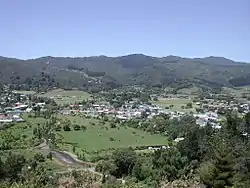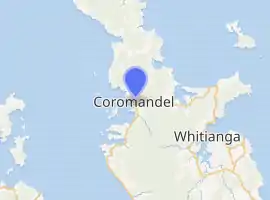Coromandel, New Zealand
Coromandel, also called Coromandel town to distinguish it from the wider district, is a town on the Coromandel Harbour, on the western side of the Coromandel Peninsula, which is in the North Island of New Zealand.[2] It is 75 kilometres east of the city of Auckland, although the road between them, which winds around the Firth of Thames and Hauraki Gulf coasts, is 190 km long. The population was 1,860 as of June 2020[1].
Coromandel | |
|---|---|
 Coromandel town | |

| |
| Coordinates: 36°45′18″S 175°30′8″E | |
| Country | New Zealand |
| Region | Waikato |
| District | Thames-Coromandel District |
| Population (June 2020)[1] | |
| • Total | 1,860 |
| Postcode(s) | 3506 |
The town was named after HMS Coromandel, which sailed into the harbour in 1820.[3] At one time Coromandel Harbour was a major port serving the region's gold mining and kauri industries. Today, the town's main industries are tourism and mussel farming.
Coromandel Harbour is a wide bay on the Hauraki Gulf guarded by several islands, the largest of which is Whanganui Island. The town and environs are a popular summer holiday destination for New Zealanders. Coromandel Town is noted for its artists, crafts, alternative lifestylers, mussel farming, and recreational fishing. One of the most popular tourist attractions is the Driving Creek Railway.
Demographics
| Year | Pop. | ±% p.a. |
|---|---|---|
| 2006 | 1,494 | — |
| 2013 | 1,518 | +0.23% |
| 2018 | 1,743 | +2.80% |
| Source: [4] | ||
Coromandel had a population of 1,743 at the 2018 New Zealand census, an increase of 225 people (14.8%) since the 2013 census, and an increase of 249 people (16.7%) since the 2006 census. There were 720 households. There were 852 males and 891 females, giving a sex ratio of 0.96 males per female. The median age was 52.5 years, with 258 people (14.8%) aged under 15 years, 243 (13.9%) aged 15 to 29, 732 (42.0%) aged 30 to 64, and 510 (29.3%) aged 65 or older.
Ethnicities were 83.1% European/Pākehā, 29.9% Māori, 2.2% Pacific peoples, 3.3% Asian, and 1.0% other ethnicities (totals add to more than 100% since people could identify with multiple ethnicities).
The proportion of people born overseas was 16.0%, compared with 27.1% nationally.
Although some people objected to giving their religion, 59.2% had no religion, 26.0% were Christian, 0.3% were Hindu, 0.3% were Muslim, 1.5% were Buddhist and 5.5% had other religions.
Of those at least 15 years old, 192 (12.9%) people had a bachelor or higher degree, and 360 (24.2%) people had no formal qualifications. The median income was $23,500. The employment status of those at least 15 was that 555 (37.4%) people were employed full-time, 249 (16.8%) were part-time, and 39 (2.6%) were unemployed.[4]
Education
Coromandel Area School is a co-educational state composite (years 1–13) school with a decile rating of 3 and a roll of 304.[5]
Coromandel Rudolf Steiner School was a small private full primary (years 1–8) school. It closed at the end of 2007.[6]
Marae
The local Manaia Marae and Te Kou o Rehua meeting house, are a meeting ground for the Ngāti Pūkenga iwi, and its Ngāti Maru hapū.[7][8]
In October 2020, the Government committed $276,216 from the Provincial Growth Fund to upgrade the marae, creating an estimated 8 jobs.[9]
The Old Coromandel Hospital is a meeting place for Te Patukirikiri iwi.[7][8]
References
- "Population estimate tables - NZ.Stat". Statistics New Zealand. Retrieved 22 October 2020.
- Reed, A. W. (2002). The Reed Dictionary of New Zealand Place Names. Auckland: Reed Books. ISBN 0-7900-0761-4.
- "HMS Coromandel". Early shipping in New Zealand waters. Archived from the original on 10 November 2013. Retrieved 10 November 2013.
- "Statistical area 1 dataset for 2018 Census". Statistics New Zealand. March 2020. Coromandel (166700). 2018 Census place summary: Coromandel
- "Te Kete Ipurangi – Coromandel Area School". Ministry of Education. Archived from the original on 29 September 2007. Retrieved 7 February 2008.
- "School Closures, Mergers and New: December_2008: Te Kete Ipurangi – Coromandel Rudolf Steiner School" (XLS). Education Counts.
- "Te Kāhui Māngai directory". tkm.govt.nz. Te Puni Kōkiri.
- "Māori Maps". maorimaps.com. Te Potiki National Trust.
- "Marae Announcements" (Excel). growregions.govt.nz. Provincial Growth Fund. 9 October 2020.
External links
![]() Coromandel travel guide from Wikivoyage
Coromandel travel guide from Wikivoyage
